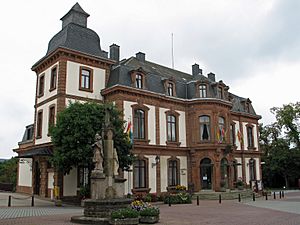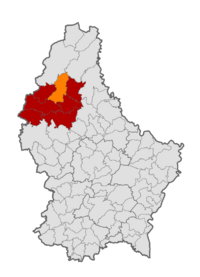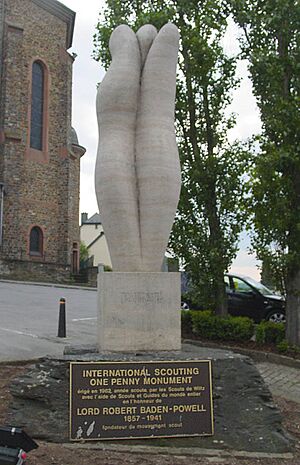Wiltz facts for kids
Quick facts for kids
Wiltz
Wolz, Wooltz
|
||
|---|---|---|
|
Commune
|
||

Town hall
|
||
|
||

Map of Luxembourg with Wiltz highlighted in orange, and the canton in dark red
|
||
| Country | ||
| Canton | Wiltz | |
| Area rank | ? of 100 | |
| Highest elevation | 518 m (1,699 ft) | |
| • Rank | 14th of 100 | |
| Lowest elevation | 285 m (935 ft) | |
| • Rank | 87th of 100 | |
| Population
(1 January 2019)
|
||
| • Total | 7,066 | |
| • Rank | 87th of 100 | |
| • Density rank | 9th of 100 | |
| Time zone | UTC+1 (CET) | |
| • Summer (DST) | UTC+2 (CEST) | |
| LAU 2 | LU0000807 | |
| Website | wiltz.lu | |
Wiltz (which locals sometimes call Wolz or Wooltz) is a town in north-western Luxembourg. It is located in the Wiltz area and sits by the Wiltz River.
Wiltz was a key battleground during the Battle of the Bulge in World War II. An airfield nearby was used by both sides during the fighting. As of 2024, the town of Wiltz has about 5,848 people living there.
Contents
Villages of Wiltz
The Wiltz area is made up of several villages. These include the main town of Wiltz and other smaller places.
|
|
History of Wiltz
The name "Wiltz" comes from an old Celtic word. It means "on the creek." The Celts were the first people to live here. Wiltz was first written about in the year 764 AD. It officially became a town in 1240. The Counts of Wiltz were some of the oldest noble families in Luxembourg.
Wiltz Castle and Industry
One of the most important buildings in Wiltz is Wiltz Castle. This castle used to belong to the Counts of Wiltz. It has many rooms and is surrounded by large lawns and gardens. The castle was finished in 1727. The last Count died in 1793.
From 1851 to 1950, the castle was a private school for girls. After that, it became a retirement home. In the late 1800s and early 1900s, the leather industry grew a lot in Wiltz. A big leather company called IDÉAL Tannerie de Wiltz S.A. helped the town's economy.
Wiltz During World War II
During World War II, German forces took over Luxembourg on May 10, 1940. On August 31, 1942, people in Wiltz started a general strike. This strike spread across the whole country.
On December 16, 1944, the German army launched a surprise attack called the Ardennes Offensive. American troops had to leave Wiltz as the Germans got closer. By the evening of December 19, the last American soldiers had left the town.
In January 1945, American troops freed Wiltz again after heavy fighting. After the war, Wiltz was called a Martyr Town. A monument shaped like a lighthouse was built to remember the people who suffered during the 1942 strike. In 2015, the nearby area of Eschweiler joined with Wiltz to form a larger commune.
The American St. Nicholas of Wiltz
In 1944, Wiltz had been under German control for about four years. Because of this, they could not celebrate their traditional St. Nicholas Day. When American soldiers arrived in Wiltz that fall, they wanted to help the children. Members of the 28th Infantry Division decided to organize a holiday celebration.
The soldiers gathered their food rations to get candy and chocolate for the kids. Corporal Richard Brookins, a tall soldier, was chosen to play St. Nicholas (called Kleeschen in Luxembourgish). He wore a priest's clothes, a beard made of rope, and a special hat made by local nuns. On December 5, 1944, he rode through town in a jeep, giving out candy.
His role as St. Nicholas only lasted a few hours. Less than two weeks later, German forces pushed back into Wiltz during the Battle of the Bulge. But the people of Wiltz never forgot what the Americans did.
In 1947, Wiltz started its St. Nicholas Day celebrations again. They wanted to honor not only St. Nicholas but also the "American St. Nick." This was a way to thank all the American soldiers who helped free Luxembourg. Richard Brookins' identity was a secret until 1977. Then, another soldier found him and gave him a message from Wiltz, inviting him back. Brookins did not know his small act had been remembered for so long.
Brookins visited Wiltz six more times, his last visit was in 2014. He was made an honorary citizen of Wiltz. In 2009, a monument was built to honor him. In 2016, Luxembourg gave him the Luxembourg Military Honor Medal. He passed away in 2018 at 96 years old.
Exploring Wiltz Town Centre
Wiltz has a calm town centre. There is an outdoor music hall where bands and classical music shows often play. From the hill near the music hall, you can see the largest lake in Luxembourg, at Esch-sur-Sure, about 20 kilometers away. A special tourist "road-train" takes visitors around the town every hour.
Wiltz also has an international soccer training field. In the middle of town, you can see a World War II tank in the main square. A popular summer event is a rave held about 10 kilometers outside town. A local farm has been turned into a pub and rave club, which is a favorite spot for scout groups.
Fun Things to Do in Wiltz
Wiltz is a big center for the international scouting movement. There are many scout campsites and buildings around the town. The International Scouting One Penny Monument, which honors Robert Baden-Powell, is in Wiltz.
Near Wiltz, on a hill, is the Sanctuary of Our Lady of Fatima. Many people visit this place every year on Ascension Day. Many Portuguese people in Luxembourg especially visit this sanctuary.
The Festival of Wiltz is a music and performing arts festival. It happens every summer.
Population Growth
Tourism and Events
In 2015, Wiltz hosted the Linuxbierwanderung, a special event for Linux fans.
Famous People from Wiltz
- Richard Brookins (1922–2018), a soldier and honorary citizen
- Kevin Malget (born 1991), a footballer
- Guy de Muyser (1926−2024), a diplomat and economist
- Romain Schneider (born 1962), a politician
- Paul Wilwertz (1905–1979), a politician
See also
 In Spanish: Wiltz para niños
In Spanish: Wiltz para niños



